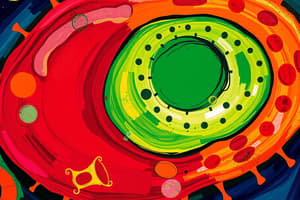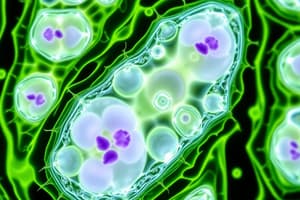Podcast
Questions and Answers
Match the following plant cell structures with their primary functions:
Match the following plant cell structures with their primary functions:
Cell Wall = Provides support and protection Plasma Membrane = Regulates the movement of substances in and out of the cell Nucleus = Controls cell growth, division, and heredity Mitochondria = Generates energy for the cell through cellular respiration
Match the following organelles with their primary functions:
Match the following organelles with their primary functions:
Chloroplasts = Responsible for photosynthesis Endoplasmic Reticulum (ER) = Involved in protein synthesis, transport, and storage Golgi Apparatus = Modifies and packages proteins and lipids for transport out of the cell Lysosomes = Contains digestive enzymes, breaks down and recycles cellular waste and foreign substances
Match the following plastids with their primary functions:
Match the following plastids with their primary functions:
Chloroplasts = Responsible for photosynthesis Chromoplasts = Contains pigments, responsible for flower and fruit coloration Amyloplasts = Stores starch, found in roots and tubers Vacuoles = Stores water, salts, and other substances, helps maintain cell turgor pressure
Match the following cytoskeletal components with their primary functions:
Match the following cytoskeletal components with their primary functions:
Match the following cell components with their primary functions:
Match the following cell components with their primary functions:
Flashcards are hidden until you start studying
Study Notes
Structure of a Plant Cell
- Cell Wall: Rigid outer layer composed of cellulose, hemicellulose, and pectin, providing support and protection.
- Plasma Membrane: Semi-permeable membrane separating the cell wall from the cytoplasm, regulating the movement of substances in and out of the cell.
Organelles
- Nucleus: Controls cell growth, division, and heredity, contains most of the cell's genetic material.
- Mitochondria: Generates energy for the cell through cellular respiration.
- Chloroplasts: Responsible for photosynthesis, converting light energy into chemical energy.
- Endoplasmic Reticulum (ER): Involved in protein synthesis, transport, and storage.
- Golgi Apparatus: Modifies and packages proteins and lipids for transport out of the cell.
- Lysosomes: Contains digestive enzymes, breaks down and recycles cellular waste and foreign substances.
- Vacuoles: Stores water, salts, and other substances, helps maintain cell turgor pressure.
Plastids
- Chloroplasts: See above.
- Chromoplasts: Contains pigments, responsible for flower and fruit coloration.
- Amyloplasts: Stores starch, found in roots and tubers.
Cytoskeleton
- Microtubules: Provides structural support, involved in cell division and transport of organelles.
- Microfilaments: Involved in cell movement, division, and shape maintenance.
- Intermediate Filaments: Provides mechanical support and stability.
Other Components
- Cytoplasm: Gel-like substance inside the cell membrane, contains water, salts, sugars, and various organelles.
- Peroxisomes: Involved in the breakdown of fatty acids and amino acids.
- Centrioles: Involved in the formation of cilia, flagella, and spindle fibers during cell division.
Structure of a Plant Cell
- Cell Wall: Composed of cellulose, hemicellulose, and pectin; provides rigidity, support, and protection to the cell.
- Plasma Membrane: Semi-permeable barrier that controls the movement of substances between the cell wall and cytoplasm.
Organelles
- Nucleus: Central hub for regulation of growth and division, housing the majority of the cell's genetic material.
- Mitochondria: Powerhouse of the cell, responsible for energy production via cellular respiration.
- Chloroplasts: Organelles that facilitate photosynthesis by converting light energy into chemical energy.
- Endoplasmic Reticulum (ER): Two types (rough and smooth); involved in synthesizing proteins, transporting materials, and storing substances.
- Golgi Apparatus: Processes and packages proteins and lipids for secretion or use within the cell.
- Lysosomes: Contains digestive enzymes that degrade cellular waste and foreign material, playing a key role in recycling.
- Vacuoles: Large storage sacs that hold water, salts, and other substances, crucial for maintaining turgor pressure within the plant cell.
Plastids
- Chloroplasts: See above for photosynthesis role.
- Chromoplasts: Contains various pigments; responsible for the coloration of flowers and fruits.
- Amyloplasts: Specialized for starch storage, typically located in root and tuber tissues.
Cytoskeleton
- Microtubules: Supportive structures that aid in cell shape, transport, and division processes.
- Microfilaments: Thin filaments that contribute to cell motility, division, and maintaining shape.
- Intermediate Filaments: Provide mechanical strength and stability to the cell structure.
Other Components
- Cytoplasm: Viscous fluid inside the cell membrane that houses organelles and is composed of water, salts, and organic molecules.
- Peroxisomes: Organelles that break down fatty acids and amino acids, detoxifying certain byproducts of metabolism.
- Centrioles: Structures crucial for forming cilia and flagella, and play a role in organizing spindle fibers during cell division.
Studying That Suits You
Use AI to generate personalized quizzes and flashcards to suit your learning preferences.




